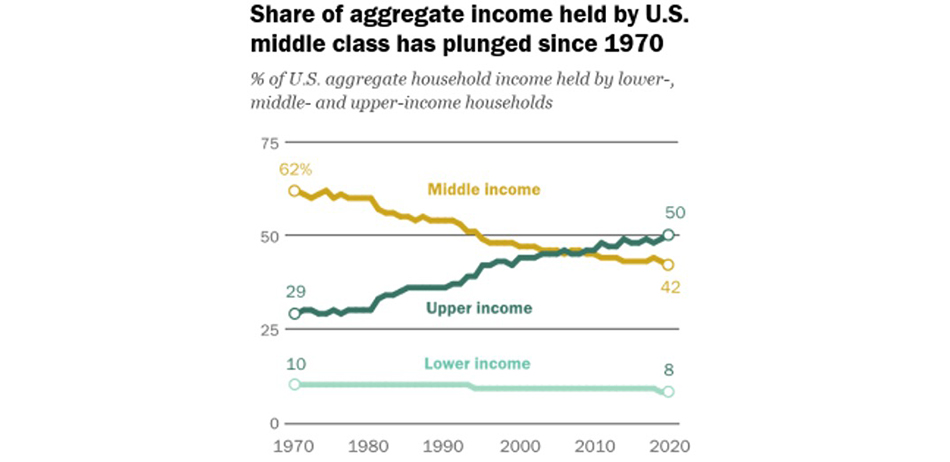The Digital Curtain
How data infrastructure was reimagined as an extension of national power.
Written by Sean Indelicato | 4 min • April 11, 2025

The Digital Curtain
How data infrastructure was reimagined as an extension of national power.
Written by Sean Indelicato | 4 min • April 11, 2025

Major shifts in American domestic and foreign policies are marking the end of a familiar global order.
After WWII, the U.S. used its economic and military advantage to build an international system through financial institutions, security alliances, and frameworks that set rules for international behavior.
 Pew Research
Pew Research
Macro-level changes occurring over this period have transformed the domestic economic landscape through the hollowing out of manufacturing, stagnating wages, and diminished purchasing power for many Americans despite rising productivity. The middle class's share of national wealth has steadily declined while asset owners—particularly in real estate, equities, and other financial instruments—have captured an increasing percentage of economic gains.
In rural communities especially, the combination of job quality deterioration and inflated living costs has fueled a narrative that frames international trade as a competition the U.S. has been losing – linking economic hardship to a deeper sense of diminished agency and community stability.
"Like the Iron Curtain that once divided East and West, a Digital Curtain is now descending across the global technology landscape. "
This change isn't simple protectionism but an emerging neo-mercantilist moment that links (rightly or wrongly) state prosperity directly to military, industrial, and technological power. This shift spans administrations in the U.S., from Biden's CHIPS Act to Trump's aggressive tariff policies, prioritizing domestic manufacturing and technological sovereignty over global efficiency.
Like the Iron Curtain that once divided East and West, a Digital Curtain is now descending across the global technology landscape. Digital sovereignty has evolved from regulatory discussions about data protection into a fundamental reimagining of digital infrastructure as an extension of national power, including:
The concept of "de-risking" is also giving way to broader economic decoupling.
With Trump's February 2025 expansion of steel and aluminum tariffs to all countries—ending exemptions even for close allies like Canada and the EU— a fundamental reconfiguration of global trade is occurring. These tariffs on basic industrial inputs, along with signals of potential new tariffs on automotive products, pharmaceuticals, and semiconductors, suggest trade fragmentation is moving beyond strategic technology sectors into foundational economic relationships. Even previously "safe" trade in basic goods is now being reshaped by geopolitical imperatives rather than mutual economic benefit.
The AI governance dilemma has transformed into a full-fledged technological arms race. NVIDIA's market dominance in AI chips has turned semiconductor policy into a critical battleground for national security, with export controls triggering massive investments in national AI chip development across competing powers.
The U.S. has employed "chokepoint" tactics to limit China's access to advanced semiconductors, and China has responded by accelerating efforts toward self-sufficiency. Take DeepSeek, China's rapidly advancing AI research lab that emerged as a response to restricted access to Western technology. Despite export controls meant to slow China's AI advancement, DeepSeek has developed large language models that approach American capabilities, often using only a fraction of the compute resources.
This acceleration creates dangerous asymmetries in AI safety standards. While some jurisdictions implement careful governance frameworks, others prioritize speed and capability over safeguards. The result is a proliferation of irresponsible AI applications that cross digital borders despite regulatory attempts to contain them.
As technological fragmentation accelerates, stakeholders face a transformed landscape requiring new approaches:
For businesses and governments in particular, this reality demands balanced strategies:
Consider how major AI labs navigate these challenges. OpenAI's approach to responsible deployment contrasts with the push for open-source models advocated by companies like Meta. Meanwhile, nation-states pursue varying approaches to AI development, from China's strategic national priority to Europe's ethical framework emphasis. Each model reflects different assumptions about the balance between innovation, security, and democratic values.
The era of assuming technological integration would naturally lead to political convergence has ended. Instead, businesses must develop approaches that acknowledge divergent values and interests while preventing dangerous fragmentation of the technologies that increasingly determine global prosperity and security. The Digital Curtain is here, and learning to navigate its boundaries will define the next era of global technological development.